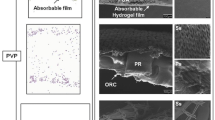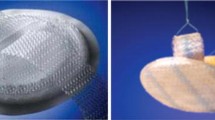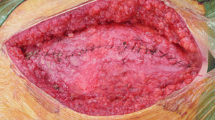Abstract
Background
Prosthetic fascial grafts are frequently used for augmentation of cruroplasty in large hiatus hernia repair to decrease the chances of recurrence. Potential complications such as intraluminal erosion may be related to the constant movement of mesh and diaphragm over the outer surface of the esophagus. This study aimed to evaluate DualMesh for repair of large hiatal defects in a porcine model.
Methods
In this study, 18 Landrace × large white × Duroc crossbred pigs underwent either primary hiatal repair or tension-free prosthetic repair using DualMesh (80 × 50 mm or 80 × 100 mm). The animals were killed at 3 or 28 weeks for macroscopic and histologic evaluation of the hiatal region and gastroesophageal junction.
Results
All grafts had become encapsulated at 28 weeks, and the majority had filmy adhesions only to the visceral aspect. In all models, the esophagus moved freely over the cut edge of the prosthesis. No signs of intraluminal erosion were documented. At histologic examination, significant ingrowth was noted on the porous side of the mesh, whereas no defined mesothelial layer was identified on the capsule of the nonporous side.
Conclusion
In this animal model of large hiatus hernia repair, DualMesh showed optimal characteristics in terms of host tissue incorporation on the porous side and absence of adhesions on the visceral side of the prosthesis. The absence of adhesions and intraluminal erosion in this study may provide reassurance to surgeons using mesh at the hiatus.





Similar content being viewed by others
References
Soyer T, Lempinen M, Cooper P (1972) A new venous prosthesis. Surgery 72:864–872
Frantzides C, Madan A, Carlson M, Stavropoulos G (2002) A prospective, randomized trial of laparoscopic polytetrafluoroethylene (PTFE) patch repair vs simple cruroplasty for large hiatal hernia. Arch Surg 137:649–652
Cristoforoni PM, Kim YB, Preys Z, Lay RY, Montz FJ (1996) Adhesion formation after incisional hernia repair: a randomized porcine trial. Am Surg 62:935–938
Boyers S, Diamond M, DeCherney A (1988) Reduction of postoperative pelvic adhesions in the rabbit with Gore-Tex surgical membrane. Fertil Steril 49:1066–1070
Hedblom C (1931) Diaphragmatic hernia: practice of surgery. Lewis Publishing Company; London, UK
Fusco EM (1960) The repair of hiatus hernia with tantalum mesh. Milita Med 125:189
Friedman MH, Mackenzie WC (1961) The clinical use of polyvinyl sponge Ivalon in the repair of esophageal hiatus hernia. Can J Surg 4:176–182
Merendino KA, Dillard DH (1965) Permanent fixation by Teflon mesh of the size of the esophageal diaphragmatic aperture in hiatus hernioplasty. Am J Surg 110:416–420
Carlson MA, Condon RE, Ludwig KA, Schulte WJ (1998) Management of intrathoracic stomach with polypropylene mesh prosthesis reinforced transabdominal hiatus hernia repair. J Am Coll Surg 187:227–230
Dutta S (2007) Prosthetic esophageal erosion after mesh hiatoplasty in a child, removed by transabdominal endogastric surgery. J Pediatr Surg 42:252–256
Coluccio G, Ponzio S, Ambu V, Tramontano R, Cuomo G (2000) Dislocation into the cardial lumen of a PTFE prosthesis used in the treatment of voluminous hiatal sliding hernia: a case report. Minerva Chir 55:341–345
Granderath F, Carlson M, Champion JK, Szold A, Basso N, Pointner R, Frantzides C (2006) Prosthetic closure of the esophageal hiatus in large hiatal hernia repair and laparoscopic antireflux surgery. Surg. Endosc 20:367–379
Cumberland VH (1952) A preliminary report on the use of a prefabricated nylon weave in the repair of ventral hernia. Med J Aust 1:143–144
Scales JT (1953) Tissue reactions to synthetic materials. Proc Royal Soc Med 46:647–652
Morris-Stiff GJ, Hughes LE (1998) The outcomes of nonabsorbable mesh placed within the abdominal cavity: literature review and clinical experience. J Am Coll Surg 186:352–367
Bellon JM, Contreras LA, Bujan J, Carrea-San Martin A (1996) Experimental assay of a DualMesh polytetrafluoroethylene prosthesis (nonporous on one side) in the repair of abdominal wall defects. Biomaterials 17:2367–2372
Bellon JM, Bujan J, Contreras LA, Jurado F (1997) Use of nonporous polytetrafluoroethylene prosthesis in combination with polypropylene prosthetic abdominal wall implants in prevention of peritoneal adhesions. J Biomed Mater Res 38:197–202
Harrell AG, Novitsky YW, Peindl RD, Cobb WS, Austin CE, Cristiano JA, Norton JH, Kercher KW, Heniford BT (2006) Prospective evaluation of adhesion formation and shrinkage of intraabdominal prosthetics in a rabbit model. Am Surg 72:808–813; discussion 813–814
Kimber CP, Dunkley MP, Haddock G, Robertson L, Carey FA, Cuschieri A (2000) Patch incorporation in diaphragmatic hernia. J Pediatr Surg 35:120–123
Acknowledgments
The study presented in this article was supported by research grants from the section of upper GI and HPB surgery at the Royal Australasian College of Surgeons and from W. L. Gore and Associates. This work is dedicated to the memory of Professor Christopher J. Martin, an inspirational esophageal surgeon and scientist.
Author information
Authors and Affiliations
Corresponding author
Rights and permissions
About this article
Cite this article
Smith, G.S., Hazebroek, E.J., Eckstein, R. et al. Evaluation of DualMesh for repair of large hiatus hernia in a porcine model. Surg Endosc 22, 1625–1631 (2008). https://doi.org/10.1007/s00464-007-9669-y
Received:
Revised:
Accepted:
Published:
Issue Date:
DOI: https://doi.org/10.1007/s00464-007-9669-y




